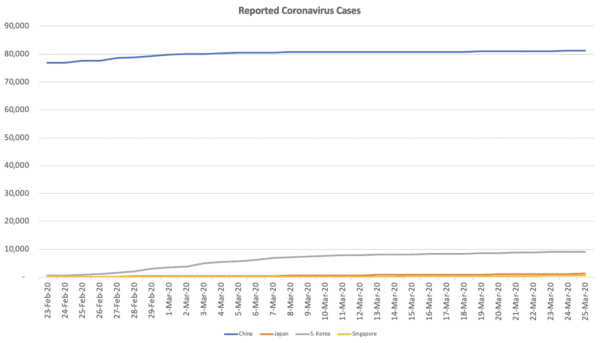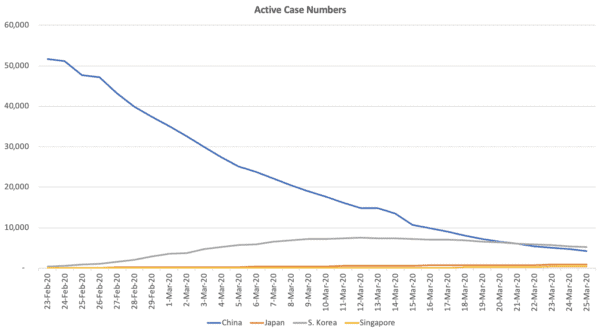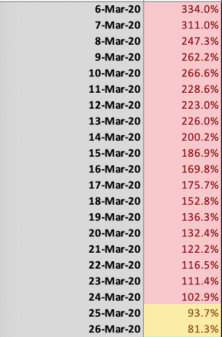One of the burning questions that is no doubt being asked by virologists, epidemiologists, medical professionals and politicians alike, is why Italy has been hit particularly hard by the novel coronavirus, Covid-19.
A quick disclosure: I am none of the above, nor do I claim to be any sort of expert. But I do have some thoughts to share.
It Could Have Been Anyone…
Until 15 February, approximately 99% of all reported coronavirus cases were limited to China. And within China, the vast majority of those cases were restricted to Wuhan in the Hebei province.
There was also a large outbreak on the Diamond Princess cruise ship, located off the coast of Japan, with a breakout within that country as well. Singapore and South Korea also appeared set for a large growth in coronavirus case numbers as well.
One thing to note is that all of these countries are located in Asia. Yet all of them have largely managed to get the situation under some sort of control.
The first chart below shows the reported coronavirus case numbers for each of those countries, while the second chart shows the active coronavirus cases (that is, reported coronavirus cases minus fatalities and recoveries).


As it stands, China now has 1.45% of the world's active coronavirus cases (down from 99%, as mentioned earlier), South Korea has 1.79%, Singapore has 0.14%, and Japan has just 0.29% of active coronavirus cases (0.33% if we include the Diamond Princess cruise ship cases as well). In fact, as of yesterday Asia had just 12.7% of the world's active coronavirus cases, compared to 64.2% in Europe and 19.6% in North America.
One big reason why Asia appears to have handled the situation better than other continents thus far is that that continent has experience dealing with similar outbreaks. SARS in 2003, for instance, forced those countries to learn from their experiences and understand how to get the situation under control. While countries like Italy and Australia were lucky to not have to endure the extremes of the SARS outbreak, we also didn't gain those valuable lessons.
As for why Italy has become the epicenter of the coronavirus crisis, I believe it could have been any other country just as easily. Many countries were slow to close their borders, including to passengers from affected cruise ships, and to understand the extreme implications they were facing.
Perhaps the openness of the Eurozone also contributed to the rapid spread of the coronavirus.
Why Is Italy's Fatality Rate So High?
Again, this is a question that many professions are desperately seeking an answer to. Based on the reported coronavirus cases, Italy's fatality rate is tragically 10.7%. By comparison, outside of Italy the fatality rate is sitting at around 3.4%.
It does not appear that Italy has a more severe strain of the coronavirus. According to The Washington Post, the coronavirus pathogen is considered to be fairly stable, meaning that it does not appear to have mutated significantly.
In fact, famed epidemiologist Larry Brilliant, who spoke to Wired, said "there's nothing in the virology that makes me frightened that we won't get a vaccine in 12 to 18 months."
It's also not due to a poor healthcare system — Lombardy (the worst affected region) has one of the best healthcare systems in the world (much better than the country's south).
Hence, it appears that there are other reasons why Italy has been struck so much worse than other locations around the world.
There are a few reasons I can think of why Italy's fatality rate might be so much higher.
First is Italy's median age. Here's some data I pulled from Worldometers:
|
Global (Weighted) |
Italy |
Spain |
China |
Australia |
|
|
Median Age (years old) |
31.3 |
47 |
45 |
38 |
38 |
|
Current Fatality Rate |
4.5% (3.4% excl. Italy) |
10.7% |
8.5% |
4% |
0.4% |
The median age represents the age at which half of all people are younger than that age, and half of all people are above that age. Hence, 50% of Italy's population is older than 47 (compared to 50% being older than 38 in Australia). Meanwhile, Wired reports that 23% of Italy's population is over the age of 65; 15.9% of Australia's population was aged over 65 as at 30 June 2019.
In other words, Italy has quite an old population. As the data shows, older individuals, and those who are immunocompromised, are typically the most vulnerable to severe cases of Covid-19 (although that is by no means to suggest that younger individuals are not at risk).
It should also be noted that, although Australia's fatality rate remains low, it will likely rise towards the global average, over time. Hence, individuals should not read this as a suggestion that the severity of the disease is not as bad in Australia as overseas.
The second reason relates to how overwhelmed Italy's hospitals have become. Without getting into detail, there are a number of horror stories relating to the choices doctors and nurses are having to make in Italy regarding which patient should be given priority treatment.
According to the CIA, Italy has 3.4 beds per 1,000 people (data as of 2012), compared to 3.8 per 1,000 people in Australia (as of 2014). Both countries compare favourably to the United States with 2.9 beds per 1,000 people (as of 2013).
In a perfect world, every infected person would be given access to the necessary resources to give them a good chance at survival. But that is simply not possible when there is a severe shortage of ICU beds and hospital staff.
This highlights the importance of social distancing and flattening the curve — by flattening the curve, we can ease the burden on the health system and give more patients priority care.
And third, it may have something to do with Italy's culture. In a nation where young people mingle more with their grandparents, it's entirely possible that that has contributed to the rapid spread, and the higher load of severe coronavirus cases. This is why young people in Australia are being told to avoid seeing grandparents for the foreseeable future.
An Improvement…
Italy is the country with the second-most coronavirus cases in the world. It has 74,386 reported coronavirus cases, 7,503 fatalities and 9,362 recoveries. Meanwhile, 3,489 individuals are considered to be in a serious or critical condition.
The spread has at very least slowed in recent days. In the past six days, the number of cases has grown 81.3%, compared to 93.7% in the six days to 25 March, and 102.9% in the six days to 24 March, as can be seen in the chart below. Hence, it does appear that Italy's lockdown laws are having a positive effect, although it still has a very long way to go.

What This Means For Australia
Unfortunately, there have been reports of a number of Italian citizens breaching lockdown laws, including this from The Sydney Morning Herald. In fact, there was even reported to have been a graduation party being illegally held in that country.
Lockdown rules as tough as those currently imposed in Italy have not been announced in Australia as yet, although we are being strongly encouraged to stay home wherever possible (here are a few reasons why that is so important).
One thing to note is that Australia appears to be moving on these restrictions sooner than Italy did, which is a positive, although we are still growing at a far more significant rate. In the past six days our number of coronavirus cases has increased 254%; if that rate is maintained we will have almost 9,500 coronavirus cases by Wednesday next week (compared to 2,676 today). Hence why the restrictions being set by the federal and state governments are so important, and why it is so important that individuals adhere to them.
And again, although Australia has a younger population than that of Italy, this does not mean that an Italy-like situation is not possible, nor does it mean young people won't experience severe cases.
Although I do not enjoy writing about things such as this, I find that it is necessary to get as much information out there about coronavirus as possible, and hope that this information will help in your understanding of what is happening, and why it is happening.
What's Happening On The Share Market?
The S&P/ASX 200 Index is sitting in the black for the third consecutive day today. The Afterpay Ltd (ASX:APT) share price is up another 27% at the time of writing to $19.07, the Bapcor Ltd (ASX:BAP) share price is up 17%, and the REA Group Limited (ASX:REA) share price has risen 9%.
Although it is impossible to know whether the market will continue to rebound, or if it has further to fall, these types of downturns do represent good opportunities for investors with a long-term focus to start nibbling at companies they like.
Ideally, given the uncertainty of the current crisis, these businesses should have strong balance sheets to weather the storm. They should be nimble enough to continue operating in this environment (for example, while some companies will be forced to cease operations altogether, others can continue with remote operations or work-from-home policies).
Foolish Bottom Line
At this time, it's hard to know how to think or feel. Many individuals find themselves out of jobs, the share market has taken a battering, while we all find ourselves restricted from activities we have, for all our lives, taken for granted.
Remember though, there are plenty of reasons to be hopeful, and that this, too, shall pass. Stay safe, Fools!







